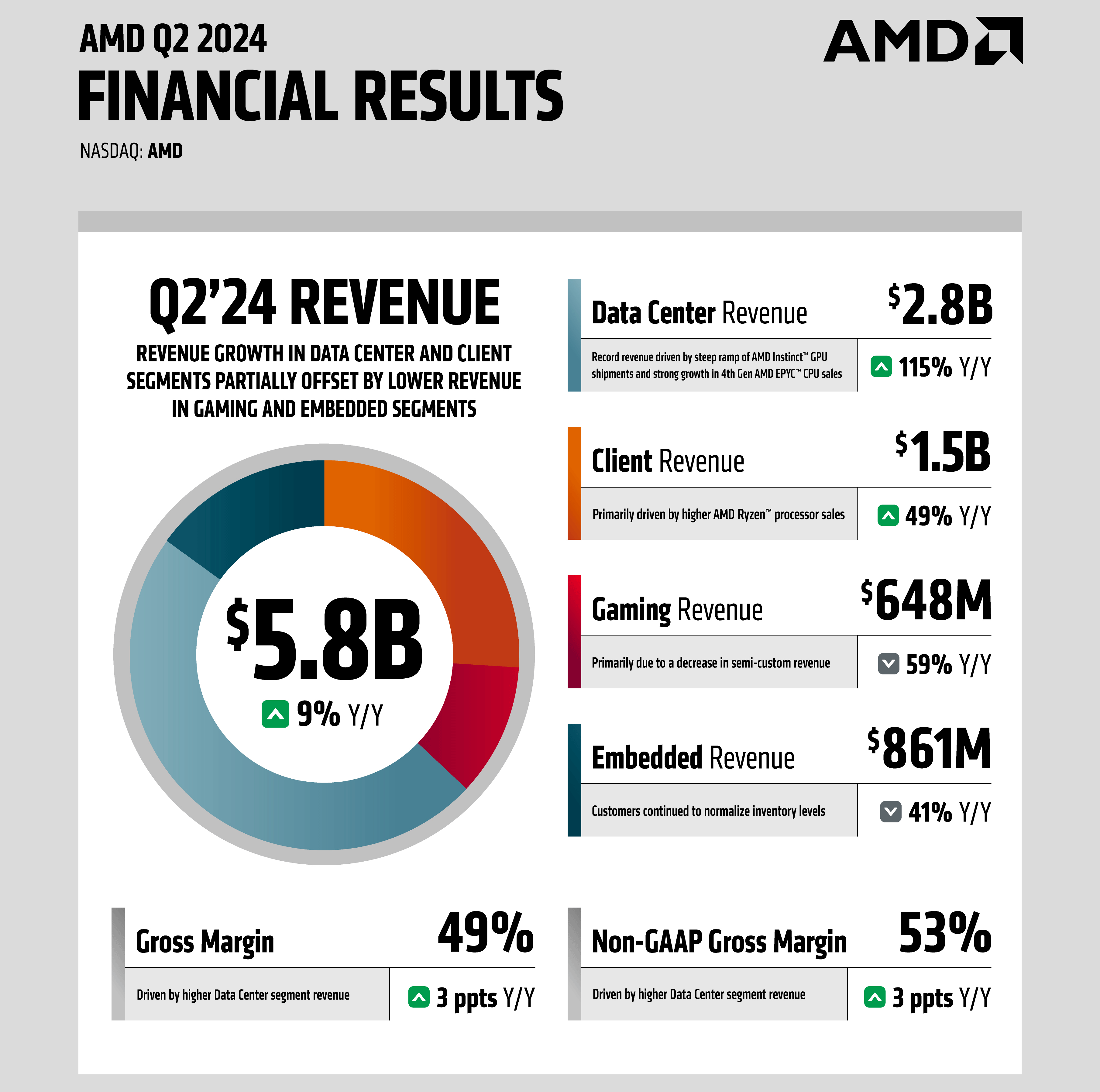AMD's gaming revenue falls 59%, but the company posts a 115% data center revenue increase
AMD expects to earn $6.7 billion ±$300 million in the third quarter.

Sales of AMD's gaming hardware dropped a whopping 59% in the second quarter of 2024 as shipments of its processors for Microsoft's Xbox and Sony's PlayStation game consoles declined. Nonetheless, record sales of data center products and massively increased sales of processors for client PCs more than offset declined gaming hardware shipments.
AMD's revenue for the second quarter of 2024 totaled $5.835 billion, up 9% year over year and 7% quarter over quarter. The company's net income reached $1.126 billion, and its gross margin increased to 53%.
"We delivered strong revenue and earnings growth in the second quarter driven by record Data Center segment revenue," said Dr. Lisa Su, chief executive of AMD. "Our AI business continued accelerating and we are well positioned to deliver strong revenue growth in the second half of the year led by demand for Instinct, EPYC and Ryzen processors. The rapid advances in generative AI are driving demand for more compute in every market, creating significant growth opportunities as we deliver leadership AI solutions across our business."
Sales of AMD's data center hardware set a record, achieving $2.834 billion in Q2 2024, up 115% year-over-year. AMD's data center business unit earned $743 million in operating income, 405% higher than in the same quarter a year ago. Additionally, AMD's revenue for the data center segment rose by 21% from the previous quarter. AMD attributes this significant growth to a sharp increase in shipments of AMD Instinct GPUs and strong sales of the 4th Generation AMD EPYC processors.
As far as sales of client processors are concerned, they were up 49% year-over-year and reached $1.492 billion for the second quarter of 2024, driven by the success of Ryzen processors. The profitability of the client computing business unit was not as high as that of AMD's data center unit and hit $89 million, which is much better than a loss of $69 million in Q2 2023.
Not all of AMD's business units performed that well. Sales of AMD's gaming hardware — comprising of Radeon graphics processors and chips for Microsoft's Xbox and Sony's PlayStation — dropped sharply to $648 million in Q2 2024, down 59% year-over-year. Still, the business division remained profitable and earned $77 million in operating income.
AMD's revenue for its embedded segment was $861 million in Q2 2024, reflecting a 41% decline compared to the same quarter a year ago, as customers continued to adjust their inventory levels. However, revenue increased by 2% from the previous quarter, a good sign for AMD's Xilinx business unit.
Get Tom's Hardware's best news and in-depth reviews, straight to your inbox.
AMD forecasts revenue for the third quarter of 2024 to be around $6.7 billion ±$300 million. This estimate suggests a year-over-year growth of about 16% and a sequential growth of roughly 15% at the midpoint of the range. The non-GAAP gross margin is projected to be approximately 53.5%.

Anton Shilov is a contributing writer at Tom’s Hardware. Over the past couple of decades, he has covered everything from CPUs and GPUs to supercomputers and from modern process technologies and latest fab tools to high-tech industry trends.
-
-Fran- Well, the Radeon division by themselves will not carry the "gaming sector" in there, but imagine if AMD said "ah, the X3D CPUs now count towards gaming". That would probably switch things ever so slightly. In fact, why do they have "gaming" as a separate from "consumer"? That's getting weird now.Reply
In any case, PS5 Pro should release soon and, maybe, drive sales up again a bit. Then again, I wonder how those numbers are getting reported for AMD since Sony would buy all those in advance? Hm...
Anyway, weird ramblings aside, it's a good report for AMD while it saddens me RTG still sucks and can't carry the "gaming" item, haha.
Regards. -
A Stoner Most of the AI performance increases seem to be in GPU type devices. Do the advances in the AI/data center help AMD to improve their graphics architecture or are they too different to benefit one another? I know nVidia benefits both AI and gaming at the same time due to the AI using the CUDA cores.Reply
Just really trying to see how the AI sales can help AMD in gaming...


